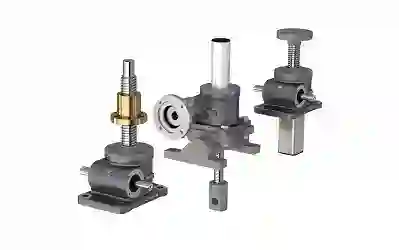
Steel structures form the backbone of modern construction, and precise alignment and secure connections are paramount for their strength and stability. Here’s where pulling screw jacks emerge as unsung heroes, providing exceptional clamping force to immobilize welded parts during the construction process and beyond.
The Challenge: Securing Welds and Maintaining Alignment
- Weld Shrinkage: As welds cool down, they contract slightly. This shrinkage can cause misalignment of components within the steel structure, potentially affecting its integrity.
- Maintaining Clamping Force: Ensuring a consistent clamping force throughout the welding process and during the initial curing period is crucial for optimal weld quality and long-term structural stability.
Pulling Screw Jacks: The Clamping Solution
- Controlled Force Application: Pulling screw jacks excel at applying controlled and precise clamping force between welded parts. This force counteracts weld shrinkage and maintains proper alignment during the welding process.
- Adjustable Clamping Pressure: Many pulling screw jacks offer adjustable clamping pressure. This allows engineers to tailor the clamping force to the specific requirements of the weld and the steel sections involved.
Benefits of Using Pulling Screw Jacks for Immobilization:
- Improved Weld Quality: By maintaining proper alignment and preventing distortion during welding, pulling screw jacks contribute to higher quality welds with improved strength and longevity.
- Enhanced Structural Integrity: Precise clamping ensures optimal joint integrity within the steel structure. This minimizes stress concentrations and contributes to the overall stability of the structure.
- Versatility in Applications: Pulling screw jacks can be used for various clamping tasks in steel structures, from beam-to-column connections to complex joint geometries.
Applications for Immobilization with Pulling Screw Jacks:
- Beam-to-Column Connections: These jacks are valuable for clamping beams to columns during welding, ensuring proper alignment and preventing weld shrinkage from compromising the connection.
- Truss Assembly: Pulling screw jacks can be employed to clamp truss members in place during the welding process, facilitating precise joint formation and overall structural integrity.
- Heavy Equipment Repairs: In repairs involving large steel components, pulling screw jacks can be used to securely clamp parts together for welding or other joining processes.
Additional Considerations:
- Anchor Points: Selecting suitable anchor points for the pulling screw jacks is crucial for effective clamping and maintaining structural stability.
- Safety Measures: Always implement proper safety precautions during welding operations, including using appropriate personal protective equipment and following established safety protocols.
Conclusion:
Pulling jack screws transcend their role as lifting tools. Their ability to apply controlled and adjustable clamping force makes them invaluable assets in steel structure construction. By leveraging these jacks for immobilization during welding, engineers can ensure the creation of high-quality welds and contribute to the overall strength and lasting integrity of these remarkable steel structures.

